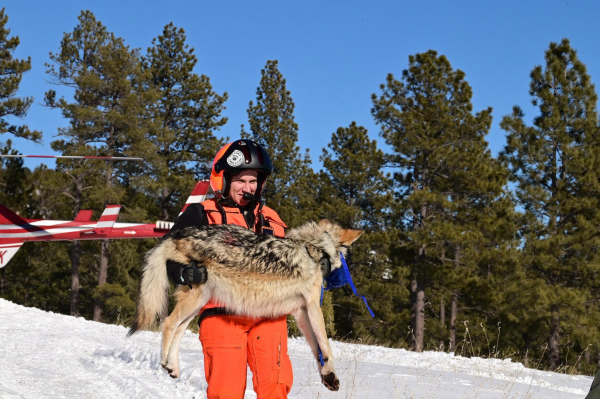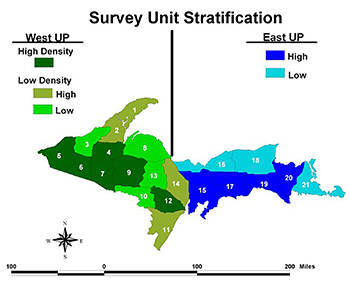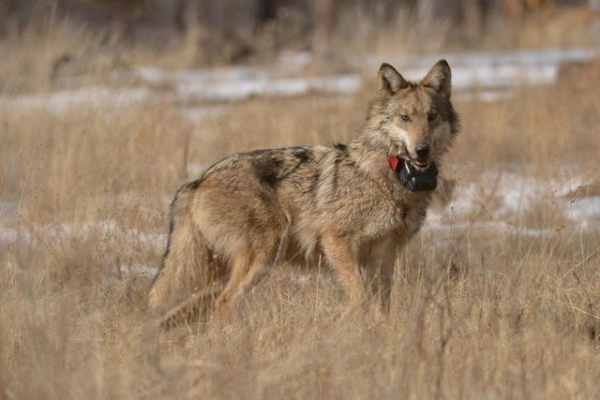Jaguar photographed in southern Arizona’s Cochise County, AZ

PHOENIX — The third jaguar documented in southern Arizona since September 2012 was photographed by a Bureau of Land Management trail camera in Cochise County. The image was taken on Nov. 16, 2016, in the Dos Cabezas Mountains 60 miles north of the U.S.-Mexico border; the camera data was only recently retrieved. This is the only jaguar photographed by this BLM-deployed camera since it was installed in August 2016. The camera remains on site.
Five Arizona Game and Fish Department scientists have independently completed an analysis of the photo, comparing the jaguar’s spot patterns to other jaguars sighted previously in Arizona. They concluded that this animal has not been previously identified. The sex of the jaguar cannot be determined by the photo.
“Since 2012, an increase in trail camera monitoring of mountainous habitat in southern Arizona has provided increased documentation and a better understanding of jaguar presence and habitat preferences,” said Steve Spangle, U.S. Fish and Wildlife Service’s Arizona Field Supervisor. “This supports the phenomenon that jaguars seeking territories outside of competitive breeding areas in Mexico continue to occasion Arizona.”
“This is a unique development. Jaguars are a historical component of Arizona’s wildlife diversity,” said Jim deVos, Assistant Director for Wildlife Management at the Arizona Game and Fish Department. “However, given the irregularity with which jaguar presence in Arizona is documented, even with the expanded use of trail cameras, this sighting is not an indication that jaguars are establishing a population in Arizona.”
“BLM managed public lands in the vicinity of the Dos Cabezas Mountains provide an important wildlife corridor and landscape linkage to the northern end of the Chiricahua Mountains,” said BLM Safford Field Office Manager Scott Cooke. “We are excited that we were able to document the jaguar utilizing public land and are pleased to share that information with our partners at the Fish and Wildlife Service and Arizona Game and Fish Department.”
A male jaguar was repeatedly documented in the Whetstone and Santa Rita Mountains 2011-2015. Another male has been twice photographed in the Huachuca Mountains in December 2016 and January 2017.
The jaguar has been protected in the U.S. as endangered under the Endangered Species Act since 1997.
Automated camera photos of jaguars and ocelots in southern Arizona (including the referenced BLM photo) are posted on the U.S. Fish and Wildlife Service Flickr page at http://bit.ly/TapYhK.
The Arizona Game and Fish Department prohibits discrimination on the basis of race, color, sex, national origin, age, religion, or disability in its programs and activities. If anyone believes that they have been discriminated against in any of the AZGFD’s programs or activities, including its employment practices, the individual may file a complaint alleging discrimination directly with the Director’s Office, 5000 W. Carefree Highway, Phoenix, AZ 85086-5000, (602) 942-3000, or with the U.S. Fish and Wildlife Service, Attn: Civil Rights Coordinator for Public Access, 5275 Leesburg Pike, MS:WSFR, Falls Church, VA 22041-3803. Persons with a disability may request a reasonable accommodation or this document in an alternative format by contacting the Director’s Office as listed above.
Arizona Game & Fish Dept. · 5000 W. Carefree Hwy, Phoenix, AZ 85086
(602) 942-3000 · www.azgfd.gov
Contacts:
Jeff Humphrey, USFWS, (602) 889-5946
Mark Hart, AZGFD, (520) 388-4445
June Lowery, BLM, (520) 258-7223






